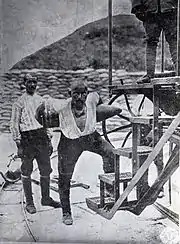Seyit Çabuk
Seyit Ali Çabuk (1889–1939), usually called Corporal Seyit (Turkish: Seyit Onbaşı) was a First World War gunner in the Ottoman Army. He is famous for having carried three shells to an artillery piece during the Allied attempt to force the Dardanelles on 18 March 1915.
Seyit Çabuk | |
|---|---|
 Corporal Seyit posing with a wooden replica of the shell. After the battle he was not able to reenact his deed for the photographer. | |
| Nickname(s) | Havranlı |
| Born | 1889 Havran, Anadolu Vilayet, Ottoman Empire (now Havran, Balıkesir, Turkey) |
| Died | 1939 (aged 49–50) |
| Allegiance | |
| Service/ | Artillery |
| Years of service | 1909–1918 |
| Rank | |
| Unit | Medjidieh Coastal Battery |
| Battles/wars | Balkan Wars Gallipoli Campaign |
| Awards | |
| Memorials | Seyit Onbaşı Memorial, Gallipoli |
Personal life and military career
Born in the village of Havran, he enlisted into the army in April 1909. After serving in the Balkan Wars of 1912–1913, he was transferred to Mecidiye Coastal Battery defending the Mediterranean entrance to the Çanakkale. Following the heavy naval bombardment of the forts guarding the Narrows on 18 March 1915, the gun he was serving in the Mecidiye fort remained operational, but its shell crane had been damaged and the other gunners in the area were injured.
Corporal Seyit, by himself, is said to have carried three artillery shells each weighing 275 kg to the 240/35 mm gun[1] and enabled it to continue firing on the Allied Fleet. He shot three rounds to the British pre-dreadnought HMS Ocean which was trying to fish sailors of HMS Irresistible hit and disabled by a mine earlier.[2] His first two shots didn’t inflict much damage but his third shot inflicted a severe injury to HMS Ocean. The shot fell under the water mechanism of the ship, causing the ship to lie down, drift towards and hit one of the mines that the mine crew of Nusret had dumped. HMS Ocean[3] capsized shortly after.
Following the repulse of the naval assault, Seyit was promoted to corporal and publicized as an iconic Turkish hero. After the Battle of Çanakkale, he was asked to have his picture taken with the shell which he famously carried. Corporal Seyit could not move the shell no matter how hard he tried. Afterwards, Corporal Seyit uttered the famous words "If war breaks out again, I'll lift it again." After that, his photo was taken with a wooden shell.
He was discharged in 1918 and became a forester and later a coal-miner. He took the surname Çabuk in 1934 with the passing of the Surname Law. He died of pneumonia in 1939. A statue of him carrying a shell was erected in 1992, just south of Kilitbahir Castle on the Gelibolu Peninsula
Further reading
References
- http://www.navyingallipoli.com/heavy_a.html
- Burt, p. 174
- "Ocean Zırhlısı Batıyor". Hürriyet (in Turkish). 18 March 2015. Archived from the original on 16 August 2015. Retrieved 11 May 2015.
External links
- Picture of Seyit Çabuk
- "Corporal Seyit". The Gallipoli Campaign. Retrieved 2007-11-05.
- "Corporal Seyit's Turkish War Memorial, Gallipoli". Digger History. Retrieved 2007-11-05.
- "Kilitbahir Fort and Corporal Seyit Memorial, Kilitbahi". Visit Gallipoli. Retrieved 2007-11-05.